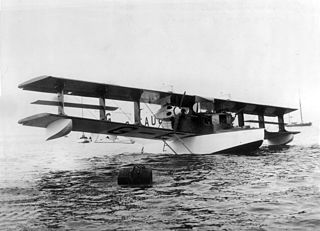
The Curtiss F7C Seahawk was a carrier-capable biplane fighter aircraft of the United States Navy Marine Corps in the late 1920s and early 1930s.

The Curtiss Models F made up a family of early flying boats developed in the United States in the years leading up to World War I. Widely produced, Model Fs saw service with the United States Navy under the designations C-2 through C-5, later reclassified to AB-2 through AB-5. Several examples were exported to Russia, and the type was built under license in Italy.

The Saunders Kittiwake was a British amphibian flying-boat built by S.E. Saunders at East Cowes, Isle of Wight.

The Boeing Model 6D, a.k.a. Boeing Model 6E, Boeing B-1D and Boeing B-1E, was an American pusher biplane flying-boat built by Boeing between 1928 and 1929.

The Dunne D.8 of 1912 was a tailless swept wing biplane, designed by J. W. Dunne to have inherent stability. One example was supplied to RAE Farnborough. License-built Burgess-Dunne models were used by the US Signal Corps and United States Navy and the short-lived Canadian Aviation Corps. It was the latter's first and only warplane.

The Albatros L.71 was a two-seat, single pusher engined biplane built in Germany in the 1920s.

The Caudron Type L was a two-seat French pusher configuration amphibious biplane, flown around 1913 and intended for naval use.
The Euler Hydro-triplane was an unusual pusher configuration amphibious triplane flying boat, built in Germany in 1913.
The Caproni Ca.61 was an Italian heavy day bomber aircraft of 1922. It was the final development of the Caproni three engine, twin boom biplane types developed during World War I, but it was not put into production.

The Denhaut Hy.479 was a French flying boat flown in 1926 and intended to be suitable for commercial or military applications. Only one, in military configuration, was built and was sometimes known as the France-Aviation Denhaut.

The Johnson Twin-60 was a small, two seat biplane intended for private owners. It had twin engines for safety and the performance and undercarriage designed for short and rough field use. Despite its refinements only one was definitely built
The Western Airplane King Bird, named after the tyrant flycatcher (Western) Kingbird, was a 1920s US civil transport accommodating three passengers in open cockpits. Only one was built.
The Hess H-2 Blue Bird was a small US transport biplane, built in the 1920s and carrying two or four passengers according to engine power.

The Thunderbird W-14 was a small, three seat American passenger transport, first flown in 1926, entering production, significantly improved, in 1927 with several different engine options. About 40-50 were built before the financial collapse of the company in 1929.

The Laird LC-B was a three seat, single-engined biplane, built for private owners in the U.S. in the late 1920s and offering a variety of engines. About 35 had been built before production ceased in the mid-1930s. Two have been restored to flight.

The Miami Maid was a US three passenger amphibian first flown in 1929. Despite ambitious production plans, only two were built.

The 1929 Curtiss Model 53 Condor, also known as the Curtiss Model 53 Condor 18 or the Curtiss CO Condor, was a civil passenger version of the Model 52 Condor bomber. A twin-engined biplane, it carried 18 passengers.

The Ireland Privateer was a 1930s American two-seat, single pusher-engined monoplane sports flying boat which could be equipped as an amphibian. About 18 were built.

The Zenith Z-6 is a single engine biplane U.S. airliner built in the late 1920s. Its cabin, in the fuselage immediately behind its radial engine, holds five or six passengers depending on engine power. It is flown from an open cockpit further aft. Nine were completed and one has been restored to flight.
The Itoh Emi 31 was a one-off Japanese civil flying boat first flown in 1922. Operated by an airline on a scheduled route for two years apart from a short break serving a newspaper, it could carry up to three passengers.


















